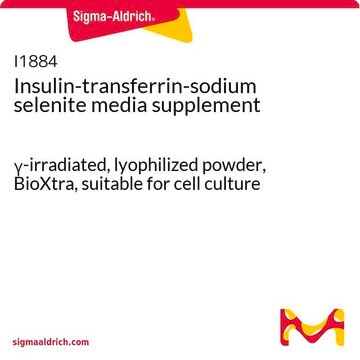N6530
N1 Medium Supplement (100×)
solution, sterile-filtered, suitable for cell culture
Synonym(e):
N1 Supplement
About This Item
Empfohlene Produkte
Sterilität
sterile-filtered
Form
solution
Methode(n)
cell culture | mammalian: suitable
Verunreinigungen
endotoxin, tested
Lagertemp.
2-8°C
Allgemeine Beschreibung
Anwendung
- a component of the proliferation medium for culturing oligodendrocyte-like cells and neuroblastoma cells
- a supplement in the Dulbecco′s modified Eagle medium (DMEM/F12) to culture human oligodendrocytes
- a component of the α-minimum essential medium (MEM) for culturing induced primary retinal pigment epithelium (ipRPE) monolayers
Sonstige Hinweise
Angaben zur Herstellung
Ähnliches Produkt
Lagerklassenschlüssel
12 - Non Combustible Liquids
WGK
WGK 1
Flammpunkt (°F)
Not applicable
Flammpunkt (°C)
Not applicable
Persönliche Schutzausrüstung
Eyeshields, Gloves, multi-purpose combination respirator cartridge (US)
Analysenzertifikate (COA)
Suchen Sie nach Analysenzertifikate (COA), indem Sie die Lot-/Chargennummer des Produkts eingeben. Lot- und Chargennummern sind auf dem Produktetikett hinter den Wörtern ‘Lot’ oder ‘Batch’ (Lot oder Charge) zu finden.
Besitzen Sie dieses Produkt bereits?
In der Dokumentenbibliothek finden Sie die Dokumentation zu den Produkten, die Sie kürzlich erworben haben.
Kunden haben sich ebenfalls angesehen
Unser Team von Wissenschaftlern verfügt über Erfahrung in allen Forschungsbereichen einschließlich Life Science, Materialwissenschaften, chemischer Synthese, Chromatographie, Analytik und vielen mehr..
Setzen Sie sich mit dem technischen Dienst in Verbindung.









